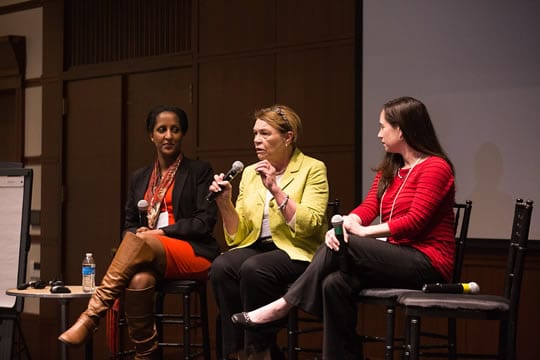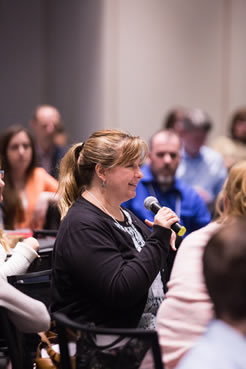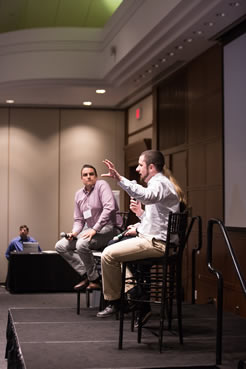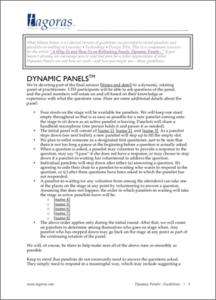
Tagoras exists to help organizations in the businesses of lifelong learning and is in the lifelong learning business itself. So, we’re running a three-part series that unpacks a few of the ways we’ve rethought typical learning formats at Tagoras events. (Read the first post, about Curated Connections TM.)
In each part of the series, I share why we used the approach and explain the how of each, to make it as easy as possible for you to try them out, whether as is or with some tweaks of your own.
The focus of this post is a format that plays with the traditional panel, and we used the format at the first Learning • Technology • Design (LTD) conference. That inaugural LTD was a two-day, placed-based event with around 100 attendees, but this panel approach could be modified to work in different contexts—online, with fewer or more attendees, etc. (We have since converted Learning • Technology • Design to an online experience.)
If your organization offers learning events (or wants to start), read on for the second of three ideas to try: Dynamic Panels™.
Dynamic Panels: The Why-To

There’s a logic to the appeal of the panel format—assemble a group of individuals knowledgeable about or skilled in a particular subject or task, and glean the benefits of their diverse opinions and experiences in the resulting back-and-forth.
And that logic is so strong that the panel format survives despite its often lackluster execution. Too often a diversity of opinions and experiences doesn’t surface. Or the back-and-forth becomes a scripted exchange of prepared statements rather than a true discussion. Or the experts on the panel forget the curse of their knowledge, and debate minutiae when the learners need bigger-picture guidance.
We developed Dynamic Panels as a way to overcome some of the common pitfalls of panels. We used a Dynamic Panel as part of the final, closing, hour-long plenary session at Learning • Technology • Design 2016. We wanted that final session to focus on application, on helping participants move from the ideas they’d heard and had over the two days to the application of those ideas as they returned to the office. Here’s how we how we described it in the program:
From Ideas to Application: Your Unanswered Questions and Moving Forward
Learning • Technology • Design is convening a community of professionals in the business of lifelong learning, continuing education, and professional development. We are united by a desire to find better ways to engage learners and create lasting impact through the effective use of technology.
The final session of Learning • Technology • Design invites you to consider what you’ve learned and what barriers you might face in applying what you’ve learned. You’ll have the chance to draw on the group’s collective knowledge, asking your unanswered questions of a dynamic, rotating panel of practitioners—and the chance to be on that panel, if a colleague’s question touches on an area where you have experience or expertise.
Co-hosts Jeff Cobb and Celisa Steele will conclude Learning • Technology • Design by offering a simple but absolutely practical plan for applying what you’ve learned.
We’re big believers in peer learning and social learning, and ending LTD with a Dynamic Panel helped drive home the point to all involved that there was tremendous knowledge and experience resident in that community of learners and that the perspective of fellow practitioners is often more valuable than that of so-called experts.

Dynamic Panels: The How-To
Here are the major aspects of how we handled the Dynamic Panel before and at the learning event.
Before the Event
- We enlisted a set of panelists for the Dynamic Panel.
We identified three participants to make up the panel initially and five more to be panelists-in-waiting (i.e., to step in and become other panelists if other learners didn’t). We identified those eight individuals from among our break-out session leaders and our advisory board. (Because most of the session leaders and the advisory boards members were practitioners, doing similar work and serving in similar positions to the rest of the participants, we were able to pull from them for the Dynamic Panel. If most of your session leaders are outsiders (i.e., doing different work or serving in different positions than most of your learners), you’ll need to take a different approach to enlisting your initial set of panelists). We also asked these eight individuals to bring one or more question to the final session.
- We prepped the initial panelists and panelists-in-waiting.
Two days in advance of the Dynamic Panel, we e-mailed the facilitators written guidelines.
In honesty, that timing cut it close. I would prefer to follow the format we used with Curated Connections—hold a brief conference call a week or two before the event, and provide written guidelines then.
We’ve created a redacted version of the guidelines we provided to the initial panelists and panelists-in-waiting for Learning • Technology • Design. Feel free to review, revise, reuse.
At the Event
- We set up the meeting space.
We used four stools on a stage. Three were filled initially, and we kept one stool empty throughout to make it easy for a new panelist to come onto the stage, as she can come and sit down as an active panelist is leaving another stool. A handheld microphone was available on each stool.
- We covered the ground rules, ran mics, and managed the flow.
At the beginning, Jeff and I teed up the Dynamic Panel, covering the why of it: to focus the final session on the issues and ideas learners wanted to ask about and to illustrate the point that there was tremendous talent and experience in the room.
We explained anyone could ask a question—if they signaled us, we’d run a mic to them. And anyone could become a panelist—if they heard a question raised that they had something to say about, they should walk up and take the empty stool. (For more specifics on how the Dynamic Panel worked and the information we offered when covering the ground rules, see the guidelines we provided to the initial panelists and panelists-in-waiting.)
We also helped with the overall flow, injecting observations and suggestions of our own when needed, and watched the clock so we could end the Dynamic Panel when time was up.
Rethinking Panels
According to The Panel Report by Kristin Arnold, 68 percent of executives and meeting organizations thought panels were okay or worse. Yikes.
So, whether you try Dynamic Panels, I encourage you to assess whether your panels deliver on their promise and to rethink how your panels might better align with your learning goals, assuming there is room for improvement. (The Leading Learning Podcast interview I did with Kristin Arnold about panels is another good resource for helping you to rethink and explore options, and the show notes include a link to download her free Panel Report.)
Celisa
See also:


 Magnificent Leadership – and Learning – with Sarah Levitt
Magnificent Leadership – and Learning – with Sarah Levitt
Leave a Reply